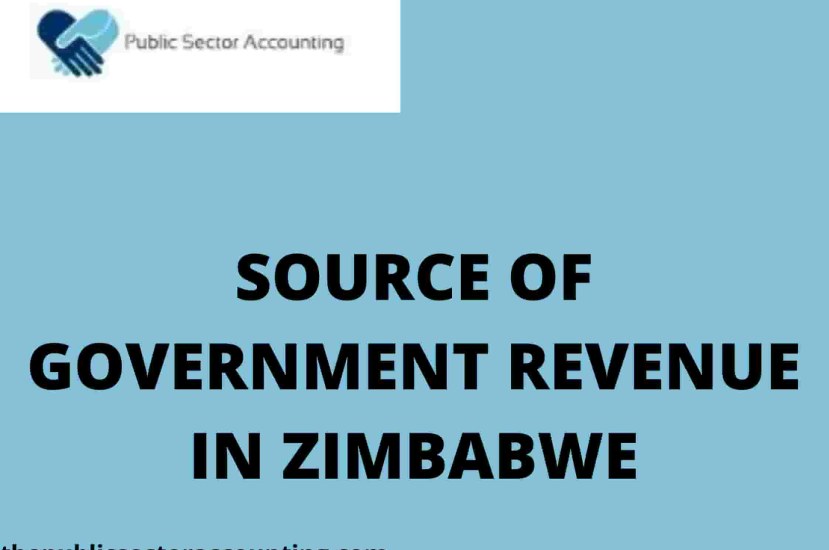Source of government revenue in Zimbabwe? is next topic in this public sector accounting
Taxes, social contributions, grants receivable, and other sources of revenue make up revenue. The gap between the government’s assets and liabilities, or net worth, is increased by revenue (GFSM 2001, paragraph 4.20).
Note that transactions that just modify the composition of the balance sheet, such as proceeds from the sale of non-financial or financial assets or the incurrence of obligations, do not impact the net worth position.
Summary of Contents
Source of government revenue in Zimbabwe
Zimbabwe’s Government Revenue Sources, it is the responsibility of the government to provide basic services to the population, such as law and order, road and port construction, schools and hospitals, and a plethora of other activities required for a modern society.
Find Out Also: OBJECTIVES OF PUBLIC SECTOR ACCOUNTING
However, in order to provide these services, the government must be able to fund them by ensuring that there is a sufficient flow of money into its hands to enable it to pay for the work it must do.
As a result, the government’s operations must rely on having an adequate financial system, which, when properly managed, will provide the necessary resources and enable them to be used in the national interest.
The central government’s financial structure has become increasingly sophisticated during the last few decades. Not only has the quantity of money moving in and out of the public treasury each year increased dramatically, but it also comes from a far wider range of sources and is used for a much wider range of purposes.
Revenue is the government’s normal income, and it is made up of taxation (which accounts for the majority of revenue) and earnings (charges raised by government departments for services rendered to the public, rents received for the lease of government lands or buildings, interest on investment by the government, and so on). This is the amount of money coming in to finance spending.
Read Also: SOURCE OF CONSOLIDATED REVENUE FUND IN NIGERIA
This pattern repeats itself year after year. Its magnitude, on the other hand, might vary from year to year, depending on whether the government decides to increase or decrease taxation or earnings, or if the economy develops naturally (for example, if everyone in Zimbabwe receives more income, the share of the tax collector will also automatically rise).
Source of government revenue in Zimbabwe PDF
Download source of government revenue in Zimbabwe PDF here
Revenue
A rise in net value as a result of a transaction is referred to as revenue. There are four main revenue streams. Property income obtained from asset ownership, sales of products and services, and voluntary transfers received from other units are all examples of coercive transfers imposed by government units.
Revenue from taxes
Compulsory transfers to the government sector make up the majority of tax revenue for many government units. Certain mandatory transfers, such as fines, penalties, and the majority of social security contributions, are not taxed.
Refunds and corrections of incorrectly collected tax income appear to be transactions that reduce the government unit applying the tax’s net worth. They are, more precisely, modifications that allow the previously reported excessive growth in net worth to be corrected. As a result, these trades are classified as losses.
On non-tax revenue, all other types of revenue are typically merged into a heterogeneous category.
Grants are non-obligatory payments made to government agencies or foreign organizations. Grants to international organizations from foreign governments would be recorded in the consolidated fund accounts. Grants can be capital or current in nature, and they can be received in cash or in kind.
Market establishment sales, administrative fees, incidental sales by non-market establishments, and imputed sales of goods and services are all examples of sales of products and services. Some administrative fees are so exorbitant that they plainly outweigh the cost of the services offered. Taxes are applied to such fees.
Sales of products and services are recorded as income before any expenses involved in generating that revenue are deducted. It’s entirely possible for government agencies to sell their products for less than their cost of manufacture.
In fact, because they are non-market manufacturers, most government agencies distribute their products for free or at low prices. In these circumstances, the unit’s net value has fallen as a result of higher production costs than revenue from sales of goods and services.
REVENUE FROM TAXES
The following are some of the sources of tax revenue:
Direct taxation:
Individuals and corporations pay direct taxes such as income tax, corporate tax, and duty. It also includes VAT and Capital Gains Tax.
Taxes levied in an indirect manner
This is a tax that the person who suffers or bears the burden does not pay directly. Individually purchased and consumed goods and services are subject to this type of tax. Taxes on general products and services, excises, customs and other imports, export taxes, and levies are among them.
Non-tax revenue encompasses all sources of income other than taxes. Grants, loans, royalties, product and service sales, and so on are examples.
Grants are non-obligatory funds received by governments or government entities from international organizations and other developed countries such as the United Kingdom, the United States, China, and France, among others.
The following items are classified as constituting tax income in the consolidated fund accounts:
INTERNATIONAL TRADE AND TRANSACTIONS
IMPORT DUTIES
- General import duties
- VAT on imports
- Penalties on import duties
- Others (non-tax revenue)
EXPORT DUTIES ON
- Cocoa
- Timber
- Diamond
- Kola Nuts
- Re-Export Levy
- Other export duties
- DOMESTIC TAXES ON GOODS AND SERVICES
- Beer
- Cigarettes
- Spirits
- Mineral water
VALUE ADDED TAX ON
- Beer
- Cigarettes
- Spirits
- Mineral waters
- Textiles (Fabric)
- Textile (Apparels)
- Soap
- Cosmetics
- Furniture
- Salt
- Radio & TV/Elect. Prod
- Rubber products
- metal products
- plasticware
- glassware
- aluminium ware
- roofing sheet
- paints
- food items
- nonalcoholic Beverage
- paper production/printing
- sawn timber
- flour
- chemical
- cement
- other local industries
- professional services
- electricity
- water
- telecommunication
- quarrying
- sand winning
- hotels & restaurant
- entertainment
- advertisement
- miscellaneous
- PETROLEUM TAXES ON
- Premium
- Kerosene
- Gas oil
- Amortization free-LPG
- Promotional Levy-LPG
- Jet Fuel (ATK)
- Industrial diesel oil
- Unified gasoline
- Bunkers
- Petroleum road fund
- Petroleum exploration Levy
- Petroleum strategic stock Levy
- Petroleum energy fund
TAXES ON INCOME, PROFIT AND CAPITAL GAINS
- Personal (Employee)
- Self-employed
- State enterprises
- Capital gains tax
- Gift tax
- Rent tax
- Mineral royalties
- Service tax
- Stamp tax
- Banderoles tax
- Penalties
- Dividend tax
- Interest
- Commission
- Management and tech. ser.
- Ceded misc. Tax
- Property rate
- Non-tax Revenue
Conclusion
The gap between the government’s assets and liabilities, or net worth, is increased by revenue (GFSM 2001, paragraph 4.20). This is the amount of money coming in to finance spending.
The central government’s financial structure has become increasingly sophisticated during the last few decades.
A rise in net value as a result of a transaction is referred to as revenue. There are four main revenue streams: direct, indirect, coercive and non-voluntary.
Refunds and corrections of incorrectly collected tax income appear to be transactions that reduce the tax’s net worth.
Non-tax revenue encompasses all sources of income other than taxes. Grants, loans, royalties, product and service sales, and so on are examples. Taxes on general products and services, excises, customs and other imports, export taxes, and levies are among them.





Leave a comment